12 What Will I Get Out of It?
Leah McCurdy and Victor Tsao
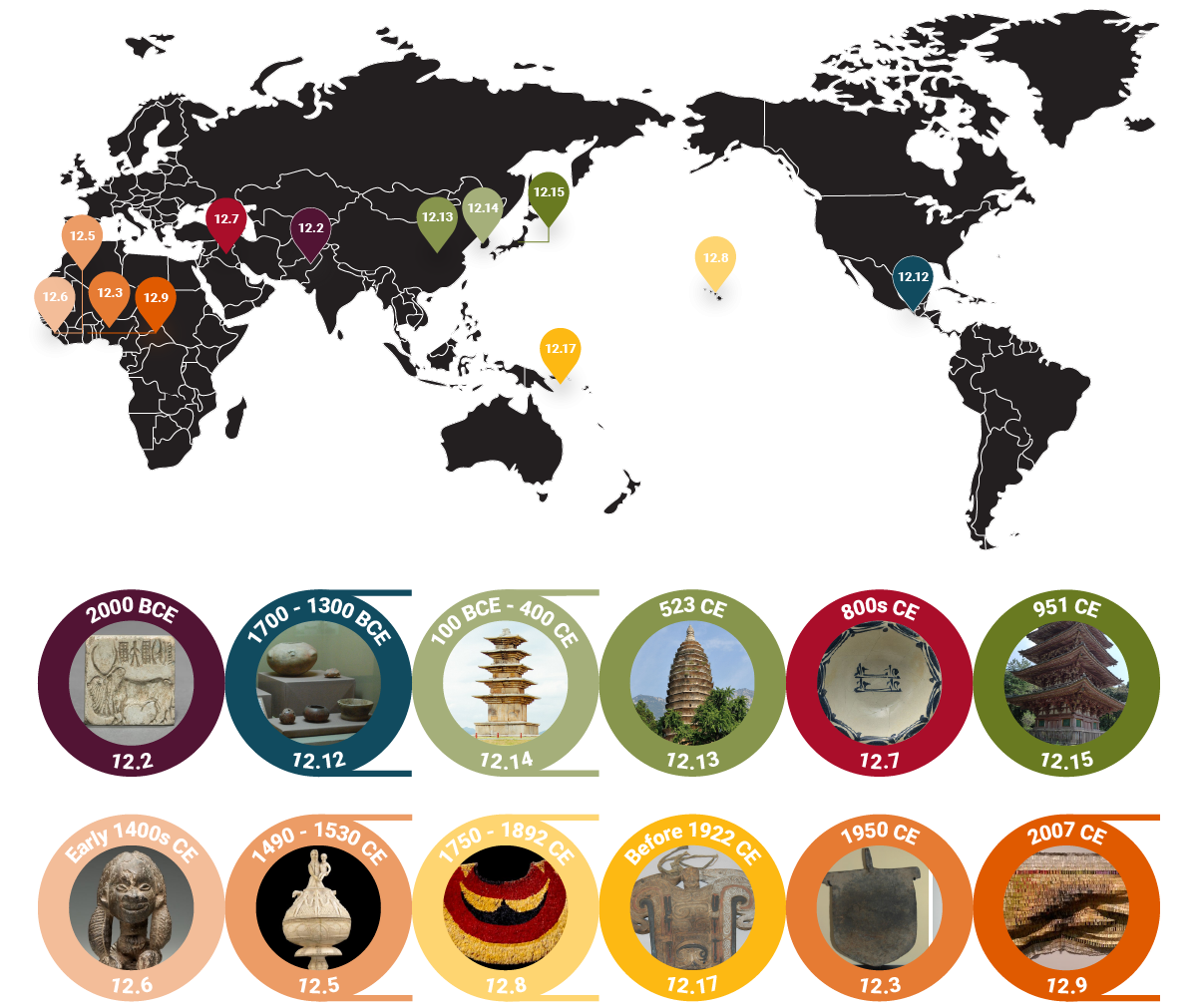
What Will I Get Out of It?
Remember all the way back to “Who Am I?” and our discussion of egocentric infants who (hopefully) eventually develop a ‘theory of mind’ of others. This is an important part of social life but it doesn’t mean that humans lose their egocentric biases altogether. Even if we understand that we’re not the only ones dealing with problems and that cultures other than our own can have distinct ways of thinking about the world, we still often think and react selfishly. Do you give all of your money away to the first person who asks? Of course not. You need that money to buy food and afford a place to live (unless you follow Shakyamuni as a monk, renounce all possessions, and live solely on the generosity of others).
As discussed in “Why Does Size Matter?”, conspicuous consumption often results in people owning and showing off possessions well beyond what anyone actually needs. We earn and save more money than our ancestors ever dreamed and/or rack up debt so we can buy jet skis and fancy shoes. This excessive consumption usually means that you, the buyer, are purchasing from a seller, who almost always is also seeking to make money for themselves and thus, make a profit off you. Exchanges of goods and services, in capitalistic economies, necessarily set up a competitive relationship between buyers and sellers. Buyers want to pay as little as possible and sellers want to profit as much as possible. Today, we often focus on another dimension of competition, that between multiple sellers of the same or similar goods. Who can offer the lowest price that will make them a profit but attract the most buyers?
Have you already asked yourself how this relates to history and art? Great question! Some of the first examples of record-keeping, that eventually led to writing systems, were developed to account for exchanges between ancient buyers and sellers. Accounting records can be pretty boring to look at but they can also be beautiful and become art! Then, there’s all the amazing stuff that ancient people conspicuously consumed!
Business deals
Let’s start with accounting records. You’ve probably seen a small clay tablet like this one. That Proto-Cuneiform tablet with seal impressions: administrative account of barley distribution… sounds super boring, but it isn’t! It represents one of the earliest forms of record-keeping and the beginnings of cuneiform, one of the first writing systems in the world! Cuneiform and the Sumerian culture that developed it in ancient Iraq are considered part of the Western Canon and thus, are widely-known in Europe and Euro-America. A lesser-known record-keeping system developed around the same time in the Indus River Valley between present-day Pakistan and India (Fig. 12.1). Seal with Two-Horned Bulls and Inscription (Fig. 12.2) exemplifies Indus record keeping and how it interfaces with traditional arts like naturalistic figure carving.
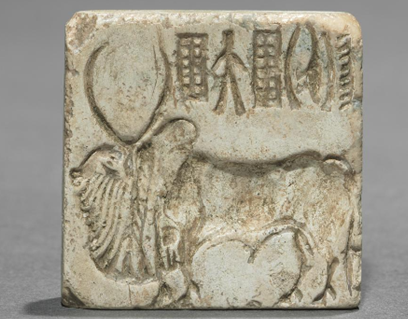
First question: why the hump-backed bull? The fatty hump, fleshy neck, and droopy ears are hallmarks of the Zebu bull (scientifically known as Bos taurus indicus) native to the Indian subcontinent. Zebus were domesticated early in the Indus Valley and became symbols of wealth and status. So, we already know a few things about the person who owned this object: they either were wealthy and socially important or wanted to represent themselves as such.
Next, check out the shadows in the Figure 12.2 photo. They indicate that the Zebu is carved not as projecting relief but as inset relief. The Zebu image is a ‘negative’ carving designed to produce a ‘positive’ image when the object is impressed into a malleable material, like clay or wax. The carved object that holds the negative imagery, as in Figure 12.2, is called a seal. It was used like a rubber stamp is used today, not to transfer ink to paper, but to transfer the negative carved image into clay. The resulting clay object (that would be kiln fired for durability) is an impression (or print) of the seal imagery and can be reproduced over and over again. So, what were those clay impressions used for?
Domesticated animals like Zebus were exchanged between Indus buyers and sellers, alongside other products like agricultural grains, manufactured goods like textiles and garments, as well as prestige items like jewelry and decorative pottery. When you buy or sell goods, you want to know which are yours and which belong to others. Indus merchants developed this system of clay impressions of stone seals to identify goods. The clay impressions could be attached to string or wood that would be affixed to an animal, a bag of grain, a door to a storage area, etc. Beyond markers of status, what information should the seal contain to adequately serve these purposes? They’ve got to include the identity of the people engaging in the exchange, right? Most scholars think that the symbols above the Zebu on the seal (Fig. 12.2) identify the owner of the seal, and thus the person engaging in transactions for which this seal was used.
The symbols are part of an ancient writing system, known as Indus or Harrapan script, that can’t really be read yet. It is basically undeciphered, meaning scholars don’t know what spoken language the symbols derive from, what the symbols represent, or what inscriptions like that in Figure 12.2 say. But, they have some guesses. Decipherment is a complex problem, so check out the summary in “Cracking the Indus Script” (Robinson 2015) or dive fully into Corpus of Indus Seals and Inscriptions, Vols. 1-3 (Parpola et al. 1987-2019). Most scholars suggest that inscriptions like that in Figure 12.2 identify the status, social role, and/or family name of the owner of the seal. For example, some seal inscriptions incorporate the symbol of an arrow, which scholars think represents the role of a warrior. Other symbols may represent roles of priests, merchants, farmers, or even rulers. Some symbols probably represent locations, such as the origin of a family household. Decipherment is ongoing, so watch this space!
So, what would Indus people pay each other with? What was their currency? We don’t know! They probably used a barter system where buyers and sellers negotiated how many bundles of grain equated to one Zebu, etc. But there may have been some objects that served as currency (a medium of exchange of mutually agreed upon value). For example, many coastal cultures around the world used shells as currency. Yapese peoples of Micronesia historically used rai (stone money; massive monolithic stones), as currency, made famous by “Spongebob Squarepants.” These weren’t meant to be mobile, like small shells in your pocket. Exchanges were negotiated without the physical exchange of stone currency (mostly). Ownership of a specific stone transferred from person to person based on verbal transactions, without needing to move any massive stones around the island. Check out “Hard Currency: Stone Money of the Yap Island” (Tuerenhout 2015) to learn more and see a photo of how rai could be moved if needed.
Some other interesting currencies include Spade Currency (Fig. 12.3; aka hoe currency) of West Africa (Fig. 12.1). These are large objects forged from iron that resemble the shape of agricultural tools such as spades (shovels) and hoes or other utilitarian objects like spears. These objects are not actually used as tools but reflect the importance of agriculture, hunting, and protection within society. They also relate to the production of food that is often the basis of small-scale exchanges, for which so-called ‘Pennies’ or thin iron rods such as in Fig. 12.4 could be used as currency.
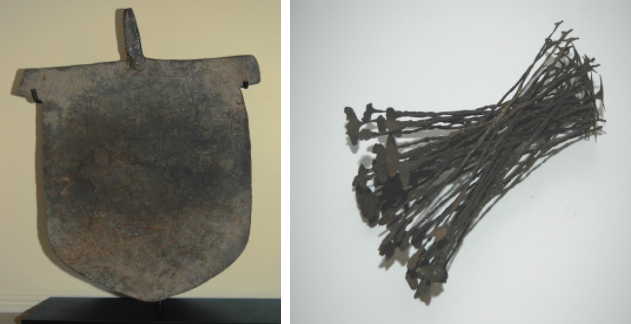
Figure 12.4 (right): Kissi Maker(s) of Sierra Leone. ‘Pennies’ (50). ca. 1950 CE. Metal, 10 ¼”. UTA African Art Collection. Photo by Leah McCurdy; CC BY-NC-SA 4.0.
Spade Currency would not be exchanged for a bag of rice. Like Yapese rai, spade currency held very high value and thus would be exchanged in large-scale transactions, for example equating to a herd of cattle in a negotiation of bridewealth (the exchange of family resources between a groom and bride’s family prior to marriage). The high value of spade currency derives from the fact that the objects comprise a large amount of iron, a metal that has its own intrinsic resource and labor value.
Spade currency can also be made out of other metals, including copper, bronze, or brass. Each metal has its own intrinsic value. For example, in the Benin Kingdom, brass was highly prized because it never tarnishes and thus symbolized longevity and beauty. Among the Kissi of present-day Liberia, Sierra Leone, and Guinea, iron is prized because of the immense labor required of blacksmiths to produce objects like the ‘Pennies.’ The Kissi view iron as a material requiring intense human engagement (through blacksmithing). Iron objects are imbued with a soul through the production process and must be treated reverently. One does not just toss iron objects around; one cares for them (like others care for paper money or coins). This intrinsic value of the material makes iron excellent as currency for the Kissi. The same sort of value-laden meaning was attributed to gold in Europe, which eventually became the standard for most global currencies today.
Exports and imports
Ancient exchange systems like that of the Indus or Kissi were mostly internal, but there is evidence that both also traded outside their culture. For example, the Indus traded with contemporaneous groups in present-day Iran and Iraq. In fact, people specialized in translation between cuneiform, Linear Elamite (from ancient Iran), and Indus script to facilitate trade. These transactions were early examples of trade along what eventually became known as the Silk Roads, connecting East Asia to Western Asia and the Mediterranean (Europe and North Africa). Other major ancient trade routes included the sea and land routes of the Indian Ocean, connecting Southeast Asia, the Indian Subcontinent, the Arab World, and East Africa. Arabs were the first to develop major trade relationships with Sub-Saharan African cultures (from their bases in North and East Africa). Eventually, European peoples like the Portuguese started their own relationships in Sub-Saharan Africa as they navigated the coasts.
Starting in the 1420s CE, Portuguese explorers sailed down the western coast of Africa aiming to establish trade routes for commodities such as spices and ivory, considered to be luxury goods in Europe. They found plenty of these resources, particularly ivory, in the homeland of the Sapi peoples, who were well-established expert ivory carvers and craftsmen living in present-day Sierra Leone and Guinea (Fig. 12.1; where the Kissi peoples live today). Sapi is the name given to these people by the Portuguese. We do not know what they called themselves.
The Portuguese were so impressed by the level of skill exhibited by the Sapi craftsmen that they commissioned special works of ivory art to present as exported gifts, sometimes called tourist items, to the European patrons funding their explorations. One such patron you may have heard of was Prince Henry the Navigator, (not actually a navigator) who funded many expeditions along the African coast. Such commissioned works often incorporated artistic elements of both the indigenous Sapi culture and European motifs, creating a distinct style of Sapi-Portuguese (aka Afro-Portuguese) ivories.
Saltcellar (Figure 12.5) is a prime example of this blended style, where elements of both cultures are clearly visible throughout the work. For starters, the physical form of the Saltcellar was a cross-cultural hybrid style. The general shape was created based on European prototypes of containers that held salt shown to the Sapi craftsmen by the Portuguese. However, the rounded forms on the saltcellar were likely Sapi in origin, representing either a dried gourd (used for storage, cooking, and ritual purposes in West Africa), or the primeval egg from which all life emanates according to Sapi tradition. This imagery would be particularly relevant to the Sapi since they associated salt with birth, life, and good health.
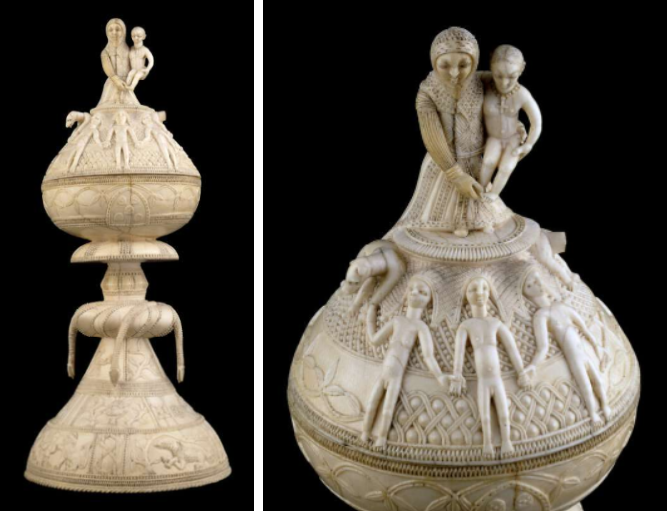
So, are you asking why the Portuguese commissioned Sapi artists to make saltcellars in the first place? Salt was an extremely valuable commodity in Europe during this period. The display of large quantities of salt in ornate ivory receptacles was a symbol of wealth and status, perfect for the European expedition patrons back home. Saltcellar and the many objects like it would not stay in Africa but would grace the dinner table of an explorer’s patron or other elite person who wanted to show off their connections to ‘exotic’ Africa.
Other evidently European influences on Saltcellar include the Madonna and child (representing the Virgin Mary and Jesus) at the very top of the lid (though the larger figure appears more like an armored soldier than the Virgin Mary), and the depiction of ‘Daniel in the Lion’s Den’ (a story for the Old Testament of the Abrahamic tradition) on the lowest register of the base. The portrayal of Christian motifs and stories marks the beginning of Christian missionizing in the region. Prior to Portuguese contact, foreign religious influence had come via the Trans-Saharan trade routes and focused on Islam. By 1400 CE, many of the people living in large communities in West Africa were Muslim (while those in smaller communities or living mobile lifestyles usually retained indigenous belief systems). The Portuguese were the first to introduce Christianity, particularly Catholicism, to the region. Although the Portuguese did not maintain a lasting colonial presence in Sierra Leone and Guinea, Portuguese colonies in other regions such as Angola and Mozambique remain highly Catholic today.
Although commissioned by Europeans, many traditionally Sapi elements are prominently displayed on the Saltcellar. Revered ancestor figures like Nomoli (Fig. 12.6) are representative of the Sapi carving style without foreign European influence. Do you notice similarities between the Nomoli figure and the figures on the Saltcellar? The head size is emphasized compared to the body. The eyes are prominent, as are broad noses and full lips, keeping to indigenous proportional traditions rather than European ones. In the art of many African cultures, the head is often large in relation to the body, highlighting its importance as the seat of intelligence and thought. When commissioned to produce saltcellars for Portuguese merchants, Sapi carvers drew upon their long-held carving traditions.
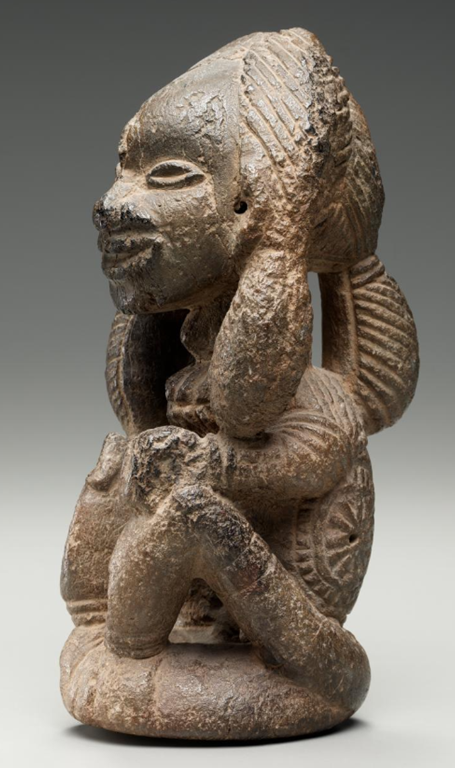
Saltcellar also features four serpents encircling and hanging from the central donut shape. In Sapi mythology, serpents were associated with water spirits called ninnegané, said to be extremely beautiful, with bright scales and smooth hair, and inhabitants of hidden underwater abodes filled with riches. According to tradition, ninnegané were born from the egg of a python, and an individual who found such an egg should take it home to incubate. The resulting serpent would provide fortune and riches for the individual and their family. In addition, the serpent was seen as a ‘master’ of iron. Blacksmiths would seek permission from ninnegané spirits prior to extracting or smelting the metal. After viewing the many iron weapons and tools of the Portuguese, the Sapi may have thought the Portuguese were in control of the ninnegané and their presence promised fortune and wealth. Depiction of serpents on Saltcellar alludes to this linkage between Sapi mythology and their Portuguese contacts.
Lastly, zoom into Figure 12.5 to spot the growling dog on the right side of the bottom register. Dogs, often portrayed in a state of alarm or frenzy, frequently make appearances on Sapi-Portuguese ivories. To the Sapi, dogs could see and feel things that were invisible to humans, often barking themselves into a frenzy over apparently nothing at all. Including dogs on the Saltcellar may represent a cultural tradition focused on alert dogs, especially if they alert one to the presence of strangers or spirits. Their presence may also be due to European influences such as hunting scenes on woodcuts shown to the Sapi artisans.
Today, the Sapi are nowhere to be found. They were displaced by the Mani invasions in the 1500s CE. The Sapi people scattered in West Africa and were likely absorbed into surrounding cultures. The Mani were ancestors of the contemporary Mende people who make up 30% of the Sierra Leonean population today and live alongside the Kissi peoples. To consider how the historic Sapi-Portuguese hybrid arts influenced later peoples of Sierra Leone and Guinea, check out “Afro-Portuguese Echoes in the Art of Upper Guinea” (Hart 2007).
Let’s explore the relationships of export and import in another region. Remember Bowl with Calligraphic Inscription (Fig. 6.9) in “What is important to us?” Bowl Emulating Chinese Stoneware (Fig. 12.7) is an earlier type of calligraphic bowl, before Samanid artists started experimenting with inscribing text around the rim. The title Bowl Emulating Chinese Stoneware already tells you that ceramic production, and ceramic objects themselves, were exchanged between potters of the Abbasid Caliphate (an Islamic kingdom) in Iraq and Chinese potters. This bowl incorporates two glazes, one of local origin and one emulating glazes of Chinese origin. The blue adornments, including the Arabic inscription reading غبطة ghibta (happiness/felicity), were produced from the mineral cobalt, which is easily obtained in Iraq and was used for many pigments and dyes. The white glaze ground simulates “whitewares” from Tang Dynasty China, which eventually led to the production of porcelain.
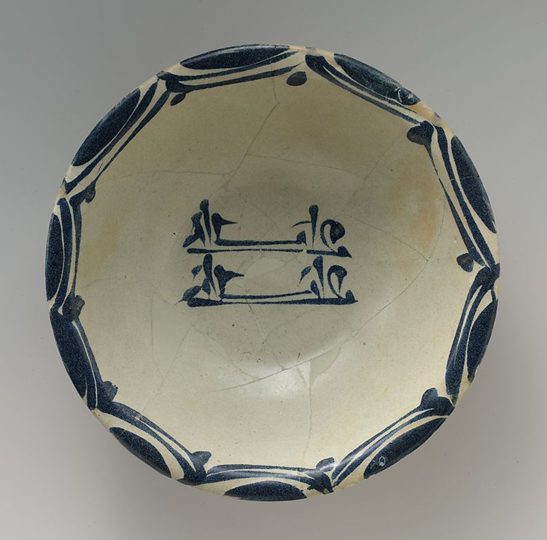
The whiteware technique was learned by Abbasid potters through observation of Tang ceramics, imported into present-day Iraq along the Silk Roads. As Tang ceramics came in, their own ceramics went out, exported into China where the rich deep cobalt blue glaze became highly appreciated. Soon, Abbasid merchants were exporting mineral cobalt, not just ceramics with cobalt glazes, to China, where potters eventually developed the coveted blue-and-white porcelain tradition. If you’ve seen Chinese porcelain on TV or in popular media, it probably was blue-and-white porcelain. All the beautiful historic blue-and-white examples from the Ming Dynasty and all the imitation dinnerware sold in shopping malls today owe their existence to trade between Western and East Asia!
Some exchanges are not so equitable. For example, many of the artworks discussed in this book were acquired via colonization. We’ll discuss some of the most inequitable examples of colonial ‘acquisition’ of art, where no exchange was taking place at all, in “Why Do People Take What Doesn’t Belong To Them?” For now, Ahu’ula (Fig. 12.8) is an example of an object obtained through exchange during colonial contact, but the story behind it reveals that it was not equitable, either in the physical sense or in the sense of power relationships.
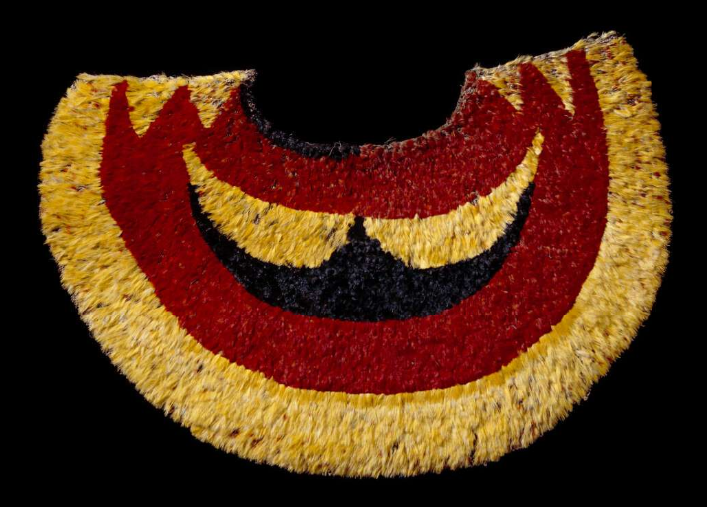
You’ve heard of Captain Cook, right? He’s known for lots of things. Let’s focus on his third voyage (1776-1780 CE) when in January 1779, he landed at Kealakekua Bay on the island of Hawai’i (after first landing in Kauai in 1778) (Fig. 12.1). There, Cook and his crew met Kalaniʻōpuʻu (the king of the island of Hawai’i) and Kamehameha I, the future king and leader of the Kānaka Maoli (the indigenous term for Hawai’ian people). The Kānaka Maoli were gathered at Kealakekua Bay for the Makahiki festival honoring the god of agriculture, fertility, and peace, Lono. The Kānaka Maoli welcomed Cook and his crew warmly.
Many people have speculated that the Kānaka Maoli attributed Cook’s arrival at that beach during that month to the promised return of Lono via canoes from the sea (since Cook had a massive sailing ship anchored offshore). This warm reception may have reflected the reverence paid to Lono but many Kānaka Maoli have challenged this interpretation, suggesting that the leaders were being hospitable and welcoming to a visitor with obvious prestige during the peacetime of the Makahiki festival (when war was forbidden due to the prescriptions of Lono worship).
Cook and his crew stayed on Hawai’i for a month. There are many stories about their activities during that time, including feasting and exchanging prestige objects. The Kānaka Maoli gifted many prized objects to Cook and his crew, including ahu’ula like that in Figure 12.8. An ahu’ula is a traditional feathered cape worn by elite Kānaka Maoli men and warriors, along with a mahiole (feathered helmet). Talk about conspicuous consumption! A cape would require several hundred thousand feathers from multiple birds to construct. But scholars think that birds were only captured and a small number of feathers removed at any one time, rather than being killed. Birds were meaningful to the design and patterning of the ahu’ula as well. Imagine the ahu’ula in Figure 12.8 stretched over someone’s shoulders. Wouldn’t it look like that person had wings?!
It is said that King Kalaniʻōpuʻu exchanged the ahu’ula and mahiole he wore at Kealakekua Bay for European prestige items, including iron tools and firearms. In addition to these pleasantries, stories also indicate that Cook’s crew engaged in consensual and/or nonconsensual sex with Kānaka Maoli women during their stay (which resulted in the spread of several sexually-transmitted diseases previously unknown on the islands). The journals of Cook and his crew differ on these accounts from the viewpoint of the Kānaka Maoli, who indicate that the sailors abused the welcome of the leaders so much that there was rejoicing when they left. Cook’s departure also coincided with the end of the Makahiki festival (keep this in mind!).
Unfortunately, just after departing, one of the masts of Cook’s ship was damaged. The crew sailed back to Kealakekua Bay to make repairs. It is said that Cook and his crew abused the Kānaka Maoli hospitality again on this second visit and eventually, conflicts broke out. There were a series of boat thefts and hostage-taking attempts (including Cook attempting to kidnap King Kalaniʻōpuʻui) on both sides, and eventually armed conflict developed on the beach. Cook, other sailors, and several Kānaka Maoli were killed in this battle. The Kānaka Maoli removed Cook’s body from the site and provided him with a funerary ritual reserved for honored people. Eventually, Cook’s crew was able to give him a burial at sea (according to British naval customs) with some of Cook’s remains returned by the Kānaka Maoli. Cook’s crew eventually returned to Britain where the gifts from the Kānaka Maoli were presented to diplomats and royalty, making their way into the British Museum collections by the 1890s CE.
The exchanges between Cook, his crew, and the Kānaka Maoli demonstrate how contact relationships can begin as amicable and/or relatively equal through exchange but eventually morph into conflict. By the time another British crew arrived in the archipelago again, Kamehameha I was well on his way to uniting all the islands into what the British called the Kingdom of Hawaii. Hawaiian royalty established trade relationships with the British, with the establishment of the first sugarcane plantation, and transformation of the native economy, in 1835 CE. During the mid and late 1800s CE, the British and American governments fought over control of trade and politics in Hawaii and participated in a number of uprisings against rival Hawaii royals who were loyal to the opposing side. The US annexed Hawaii as a territory in 1898 CE.
Like in Hawai’i, British colonists had strong influence in the colony they called the Gold Coast, known after independence as Ghana. The first Europeans to create settlements in Ghana were the Portuguese who built a coastal fort called Castelo da São Jorge da Mina (Elmina Castle) in 1482 CE. Their intentions were clear from the beginning; mina means ‘mine’ in Spanish. Ghana contains large gold deposits. The British, Danish, and the Dutch succeeded the Portuguese in control of the Ghanaian coast for many years, building a large port for the West African slave trade over time (within which African kingdoms participated). Eventually, a kingdom called Asante (aka Ashanti; with royalty deriving from the native Akan culture from which the akua’ba tradition discussed in “Where Do Babies Come From?” derives) developed in the early 1600s CE and was thriving by 1717 CE. The Asante invaded the European-controlled coast, eventually forcing the Dutch out and signing treaties ‘of friendship’ with the British African Company of Merchants. After some less-than-friendly events, the British fought four Anglo-Asante wars from 1824-1900 CE, eventually burning the Asante capital at Kumasi, and acquiring Asante territory. Ghana gained independence from Britain in 1957 CE.
From the 1500s to the 1800s CE, millions of Africans were enslaved in West and central Africa and transported across the Atlantic to the Americas. Transatlantic slave trade routes were administered at various ports along the coasts, including Elmina Castle and other forts built by the Portuguese, British, Spanish, French, Dutch, and Danish. The Gold Coast colony accounted for over 10% of the total African slave trade between 1650 and 1900 CE. Around 2 million enslaved people died onboard the ships, due to horrific conditions. Those that reached the Americas were spread from the colonial coasts of North America, the Caribbean Islands, throughout Spanish Central American coasts, and across Portuguese and Spanish colonies of South America. Most enslaved Africans were forced to work for Euro-America landowners, often on cotton and sugarcane plantations.
Speaking of sugarcane… what can it make, other than granulated sugar? Alcohol. Sugarcane can be processed and fermented to produce ethanol, or ethyl alcohol (aka drinking alcohol). When combined with flavors, rum can be produced from sugarcane, along with other liquors like Brazilian cachaca. Liquors produced via slave labor in the Americas were introduced into West Africa by Europeans, leading to huge markets for imported alcohol in the region. Contemporary Ghanaian artist El Anatsui uses metal bottlecaps and aluminum wrappings from liquor bottles to produce stunning works of art like Seepage (Figs. 12.9 & 12.10). Listen to Anatsui describe the meaning behind these materials in El Anatsui links three continents through liquor (Fig. 12.11).


Anatsui describes the visual links to Kente cloth in the video. Kente is a traditional woven textile in Akan culture, typically worn on special occasions and mostly by wealthy people who can afford woven fabrics. Anatsui’s works also often allude to another Akan textile tradition, called Adinkra. Dyed fabric is stamped with Adinkra symbols to produce patterned textiles, traditionally worn by royalty and elites at funerals. Today, Adinkra is seen throughout Ghana, worn by all people, and representative of heritage. Adinkra symbols relate to the vast tradition of Akan proverbs and metaphors that pass wisdom between generations. By choosing to relate to long-established Akan traditions of Kente and Adinkra, Anatsui may be reflecting upon whether generational wisdom has done its job in combating the impacts of alcoholism and related social concerns. This is a question that is applicable everywhere, not just in Ghana.
Let’s not leave this section on a sad note. Let’s move from alcoholism to choco-holism! The history of chocolate involves a ton of trade. Chocolate comes from cacao beans, which form in pods, which grow on trees native to the Amazon. As far as we know, early Amazonians didn’t domesticate cacao trees but they did collect wild cacao pods and create chocolate from wild beans. They traded cacao pods and beans for other goods and over time, cacao made its way north into present-day Mesoamerica. Archaeologists originally thought that the earliest evidence of cacao in Mesoamerica was found in Honduras and Belize, until a group of researchers applied a chemistry technique to pottery from Mexico and Guatemala! Check out “Oldest Chocolate in the New World” (Powis et al. 2007) for all the details.
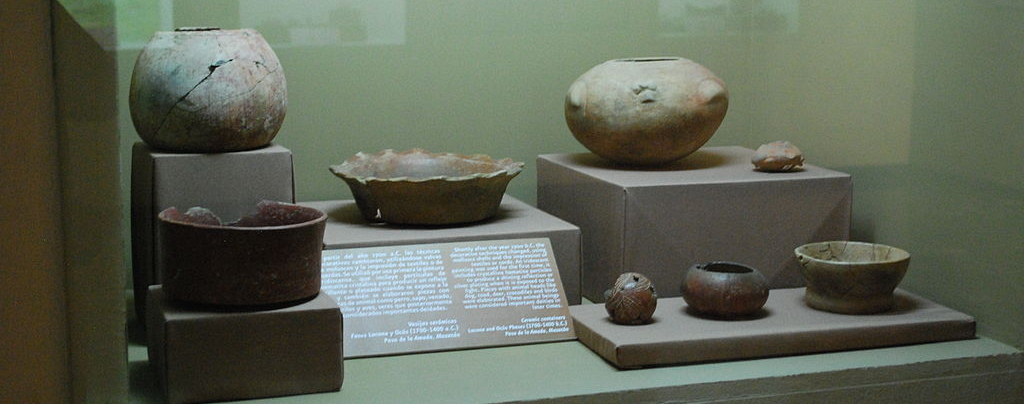
Barra style ceramic vessels (Fig. 12.12), made by Mokaya people of the Pacific Coast of present-day Mexico and Guatemala (Fig. 12.1), are not the art-iest vessels in the world. But many of them provide evidence of ancient trade and consumption. Based on techniques developed in collaboration with the Hershey Institute, archaeologists used liquid chromatography and mass spectrometry (LC/MS) to test whether Barra vessels retained the signature chemical compounds of cacao (theobromine and caffeine). You guessed it… they did! This evidence demonstrates that Mokaya were choco-holics by 1900-1750 BCE. Archaeologists also found that Pre-Olmec peoples of the Gulf Coast region were storing chocolate in their ceramic vessels around 1750 BCE. There’s enough evidence of cacao consumption in the Pacific Coast to suggest that they weren’t just seeking cacao pods through trade but planted their own and were farming cacao.
By the Late Classic Period, the Maya were choco-holics, too. In fact, Vessel of the Dancing Lords (Fig. 7.4 in “Will You Tell A Story?”) is specifically identified as a ‘cacao-drinking vessel’ in the upper band of hieroglyphs. But, if you’re thinking it would serve some sweet, milky hot chocolate of today, no luck. Ancient Mesoamericans preferred their cacao drink room temperature and bitter. Still, it was chocolate! And, of course, cacao didn’t just stay in Mesoamerica. They traded it to northern neighbors as well. Eventually, cacao reached the Fremont peoples of present-day Utah by 750 CE along long-distance trade routes illustrated in this map by the Natural History Museum of Utah. Along those routes, cacao also made its way into the hands of Ancestral Puebloans at Chaco Canyon (also discussed in “Will You Tell a Story?”). Check out “Cacao in Chaco Canyon” (Mozdy 2016) to learn about finds by archaeologist Patricia Crown. And, yes, archaeologists can devote their entire career to chocolate!
Diffuse ideas
While consuming and profiting directly relates to tangible objects (like liquor bottles and cacao pods), the processes of exchange also incorporate intangible exchanges of language, ideas, and beliefs. This intangible movement and exchange is often called cultural diffusion, as ideas spread out from their origin point into neighboring and even far-afield regions. In “Will You Tell a Story?”, we discussed the diffusion of Greek artistic ideals, especially the depiction of the human body and facial features, into the Gandharan region (present-day Pakistan). That diffusion influenced the depiction of Buddha and his jatakas like the Dipankara Jataka (Fig. 7.11). In “What is Divine?”, we discussed the diffusion of Buddhism itself, from its origins in the Indian subcontinent into Tibet and into Southeast Asia. The massive Borobudur temple complex in Java (Fig. 11.14; “Why Does Size Matter?”) evolved from original Indian stupas, demonstrating the diffusion of Buddhist architectural styles. What else evolved from stupas?
Pagodas! As Buddhism began spreading into Tibet and along the Silk Roads into China around 250 CE (maybe as early as 68 CE), traditional Chinese architectural (TCA) style was already well established. The style wasn’t exactly the same as the eventual Ming Dynasty style seen in The Forbidden City (Fig. 11.4; “Why Does Size Matter?”) but it was close. Check out the Han Dynasty House Model in “Why Do They Have More Than Us?” to see an early example. As the idea of the stupa reliquary travelled into China, it morphed from a mound shape and became a tiered tower. That tower form seems to have strong visual resonance with the yasti (spire) feature of most Indian stupas, discussed in “Why Does Size Matter?”.
As is characteristic of the TCA style, the original pagodas were built of wood, with projecting eaves supported by intricate dougong bracketing systems. They were probably square or circular towers. Eventually, hexagon and octagonal towers developed. As far as we know, none of those earliest wood pagodas survive in China today (though we know of several from written accounts, such as Luoyang quielan ji [A Record of Buddhist Monasteries in Luoyang] by Yang Xuanzhi from around 547 CE). By around 400 CE, pagodas were also built out of brick or stone in China. Songyue Pagoda (Fig. 12.13) is the oldest surviving brick pagoda, built with an octagonal base and 14 successive eaves that form a conical top. Figure 12.16 details the brickwork beneath each eave at Songyue Pagoda. This is a simplified way of representing the wooden dougong system of TCA in a new material.
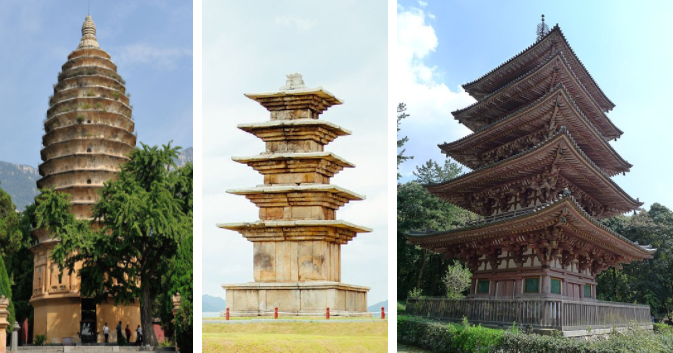
Figure 12.14 (center): Mahan Period Maker(s) of Iksan, South Korea. Wanggung-ri Pagoda 익산 왕궁리 오층석탑. ca. 400 CE. Stone, 8.5 m. In situ. CC BY-SA 4.0.
Figure 12.15 (right): Maker(s) of Kyoto, Japan. Pagoda of Daigo-ji Temple. 951 CE. Wood. In situ. Photo by Motokoka; CC BY-SA 4.0.
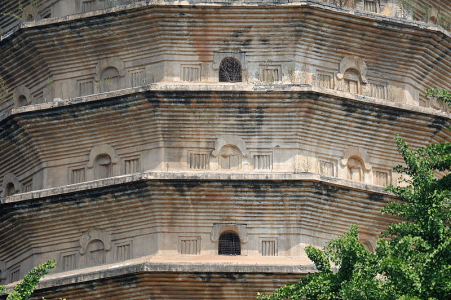
Once Buddhism reached China, it was not long before it reached Korea, around 372 CE. Wanggung-ri Pagoda (Fig. 12.14) is one of the oldest Korean pagodas, which are typically built of stone and rectangular, using similar stacking techniques beneath the eaves to simulate layered brackets. Buddhism reached Japan around 550 CE. From that point until today, Japanese pagodas are built of wood. TCA style had been influential in Japan prior to the introduction of Buddhism but merged with Shinto architectural style (as seen in Naiku Shrine [Fig 4.12 from “What is Divine?”]). The Pagoda of Daigo-ji Temple (Fig. 12.15) was built with a square base using these merged wood building techniques. Check out those dougong! All of these examples demonstrate the change that occurs through cultural diffusion.
Givin’ and gettin’
Let’s end our discussion of trade and exchange with ceremonial exchange. You probably know what that is even if you’ve never practiced it. Heard of Hanukkah or Christmas? These are Jewish and Christian traditions of ceremonial gifting. Today, these traditions focus on reciprocal gift exchange, whereby you are (typically) expected to give someone a gift if they give you one. Reciprocal ceremonial exchange is seen in many parts of the world. One of the most interesting examples requires a canoe!
Off the northeastern coast of Papua New Guinea in Melanesia (Fig. 12.1), there is a small archipelago inhabited by Massim peoples, known as the Trobriand Islands (named after a French naval lieutenant in 1793 CE). The Massim system of ceremonial exchange is known as kula and was made famous in Europe and Euro-America by anthropologist Bronislaw Malinowski (1932) in Argonauts of the Western Pacific. Kula is a practice of venturing out from one’s home island in a specifically adorned canoe towards the island of one’s karayta’u (exchange partner) to participate in ceremonial exchange.
Before you get in your canoe, you have to ‘buy into’ the kula system by purchasing the appropriate types of objects that are exchanged. You can’t just exchange anything (at first); you’ve got to come with either a mwali (white shell armband) or a soulava (red shell disk necklace). If you can’t afford a mwali or a soulava, then you can’t participate in the kula. Thus, the kula is exclusive to the wealthiest people in society, typically the chiefs.
So what does a fancy kula canoe look like? Check out this photo of a contemporary example, based on historic designs. Didn’t expect that, did you? Maybe you thought kula canoes were dinky vessels for only one person. On the contrary, you need a well-appointed canoe to navigate ocean waves! It’s got to be sturdy, large enough to fit a crew to work the sail, and present your identity to your karayta’u as you arrive. Canoe Prow (Fig. 12.17) was salvaged from an historic kula canoe. Do you notice a similar t-shaped painted object on the canoe in the photo linked above? That’s a similar prow decorated in the traditional style.
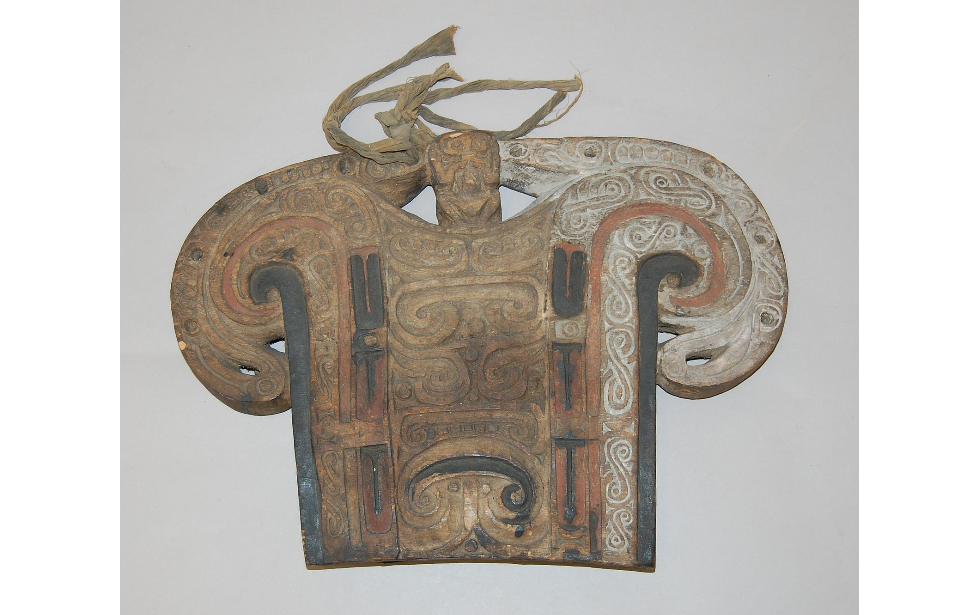
Kula canoe prows are carved from wood and painted red, black, and white. They always feature curvilinear designs that resemble ocean waves. Carvers often include human figures (as seen at the top center of Fig. 12.17) representing ancestors, and sea birds. Much of the imagery is abstracted scrolls, spirals, and knots. These canoe prows are designed to stand out against the blue of the ocean and the brown of the sand so that when you arrive, your karayta’u recognizes you and prepares for kula exchange.
Exchanges always begin with announcements and honoring of the partners. Then, mwali and soulava are exchanged (based on where the destination is within the chain of islands). After that, karayta’u may host their visitor in their home, offer them food, or trade other items with them. Anthropologists think that kula ceremonial exchange serves an important social function. The Trobriand Islands are small and Massim populations on each island are small. If you were only to trade and interact with the people on your home island, you would be really limited. Thus, off-island trade is crucial. Off-island relationships are also crucial to avoid the negative consequences of inbreeding. If you produce offspring with someone who is too close to you genetically, there can be significant issues for the child. In addition to trading objects, kula karayta’u could develop social relationships that would build marriage partner networks to ensure healthy genetic diversity in their island populations. Multidimensional exchange like this also occurred along the Silk Roads, across the Indian Ocean, and throughout the Americas.
The Wrap-up
How has trade and exchange impacted your life? How do you assign value to objects? Do you participate in any ceremonial exchange practices? As these examples in this chapter demonstrate, while the objects exchanged are important, it is often the intangible outcomes of exchange that impact us the most. As you explore the News Flash links and check out the scholarly resources below, consider what role exchanges, ceremonial or everyday, play in your life and within your communities.
News Flash
- Want more info about the Indus? Pursue the Harappa.com Blog where you can read about Haider Ali’s transformed VW Bug dedicated to Mohenjo-Daro!
- Check out a documentary created by anthropologist Gina Knapp in 2017 called “Updating Kula.”
- El Anatsui is on Instagram! @elanatsuiart
- Check out “The Pacific: In the Wake of Captain Cook with San Neill,” a documentary about Cook’s voyages and his controversial legacy
Where Do I Go From Here? / The Bibliography
Robinson, Andrew. 2015. “Ancient Civilization: Cracking the Indus Script.” Nature 526: 499-501. https://doi.org/10.1038/526499a.

